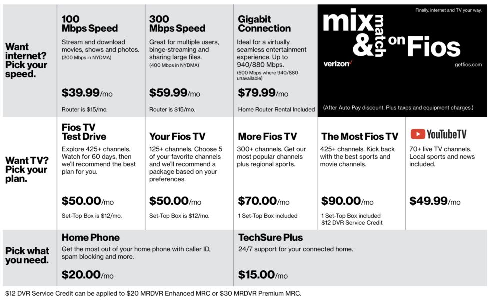Verizon Fios’ new “Mix & Match” points to a larger shift toward consumer-friendly pricing and packages in 2020
Yesterday, Verizon announced significant changes to its Fios services with the launch of “Mix & Match,” a bold new approach to internet and TV pricing. With Mix & Match, Verizon eliminates service contracts and hidden fees, offering its customers more choice in their internet and TV plans, the flexibility to change packages month-to-month, and greater transparency by eliminating hidden fees. This change is a prime example of Comperemedia’s 2020 Telecom and Media Trend ‘All Clear’ which predicted that telecom providers would reduce service complications and “gotchas” in 2020 to make services, agreements, and communications clear and simple for customers.
Why now?
Providers across the industry have been aware for years of common consumer frustrations around changing or surprise fees on bills, the inability to drop a service provider in the middle of a contract without steep penalties, and exploding offers. Yet, to-date, we’ve seen only minor changes from the major multichannel video programming distributors (MVPDs) and carriers to address these pain points, with the exception of T-Mobile, which has had great success by systematically addressing a long series of frustration points.
2020 is a turning-point year, driven in large part by the expanding market of streaming video. As consumers have become accustomed to streaming video services, they have come to expect some similar, welcome features from all of them, including month-to-month flexibility, easy-to-understand packages, and simple billing practices. As more SVODs enter the space in 2020, consumers continue to appreciate the flexibility to swap in and out of these services, and they will exercise their right to do so more than ever before (for more on this, check out our 2020 Telecom and Media Trend ‘The Big Swap-out’). The more consumers exercise their freedom to switch back and forth between streaming providers, the more pronounced and distasteful cable’s antiquated contracts, exploding offers, and hidden fees become.
Additional pressure comes from the maturing streaming live TV market. Virtual MVPDs, once a cheaper (and skinnier) alternative to cable, have increased the size of their content bundles, as well as their prices. Now, vMVPDs look more like cable TV than ever before, except that they offer the advantages of streaming video, including no contracts, simple plans, and easy billing (among others). Legacy players are realizing that they have to make some changes in order to compete.
Mix & Match
Fios has responded to the changing marketplace dynamics with Mix & Match for both its video and internet offerings. The new menu includes a choice of three internet speeds ranging from $55 to $80/month, including router fees. It also offers a selection of TV packages, starting at $50/month. Customers, including existing subscribers, are no longer required to sign on for a one- or two-year commitment. This is a dramatic departure from the way TV and internet packages are typically offered—as part of a bundle, on contract, with loads of fine print.
The new tactic enables Fios to cater to, and capitalize on, the changing needs of customers. The flexibility to change one’s TV and/or internet package with a household’s varying consumption needs or fluctuating finances could offer valuable peace of mind to long-term customers. Fios may also be able to capture a different segment of short-term users, such as those who want access to a live TV package, or a package of networks, for a month or two to watch the new season of a favorite series in real-time or to catch a major sporting event. Typically, they would have to choose a vMPVD for short-term live TV, but Fios Mix & Match might now be an option for them. However, Fios would still have to convince a would-be short-term video subscriber that it’s worth it to set up the Fios set-top box for a brief period of time, and then return it.
For many consumers, especially those used to streaming all of their video content, having to set up and return hardware for short-term use could be a deal breaker—it’s an area where streaming video providers have a distinct advantage. However, Verizon may be able to convince consumers that the added hardware is a worthwhile exchange for a better viewing experience. Because streaming live TV services are still coming up short in handling high-traffic live events, and that would be a clear advantage for Fios.
Room for improvement

As shown in the Fios menu, Verizon is still breaking out its router and set-top box fees separately, despite “eliminating fees.” Additionally, taxes will be charged separately (taxes are not rolled in either, probably because there are a lot of them, they’re complex and vary from one market to the next), which could surprise consumers expecting simpler, less surprising Fios bills. One immediate step could be to roll the equipment fees into the advertised price point, adding a friendly marketing message like “set-top box rental included!”



